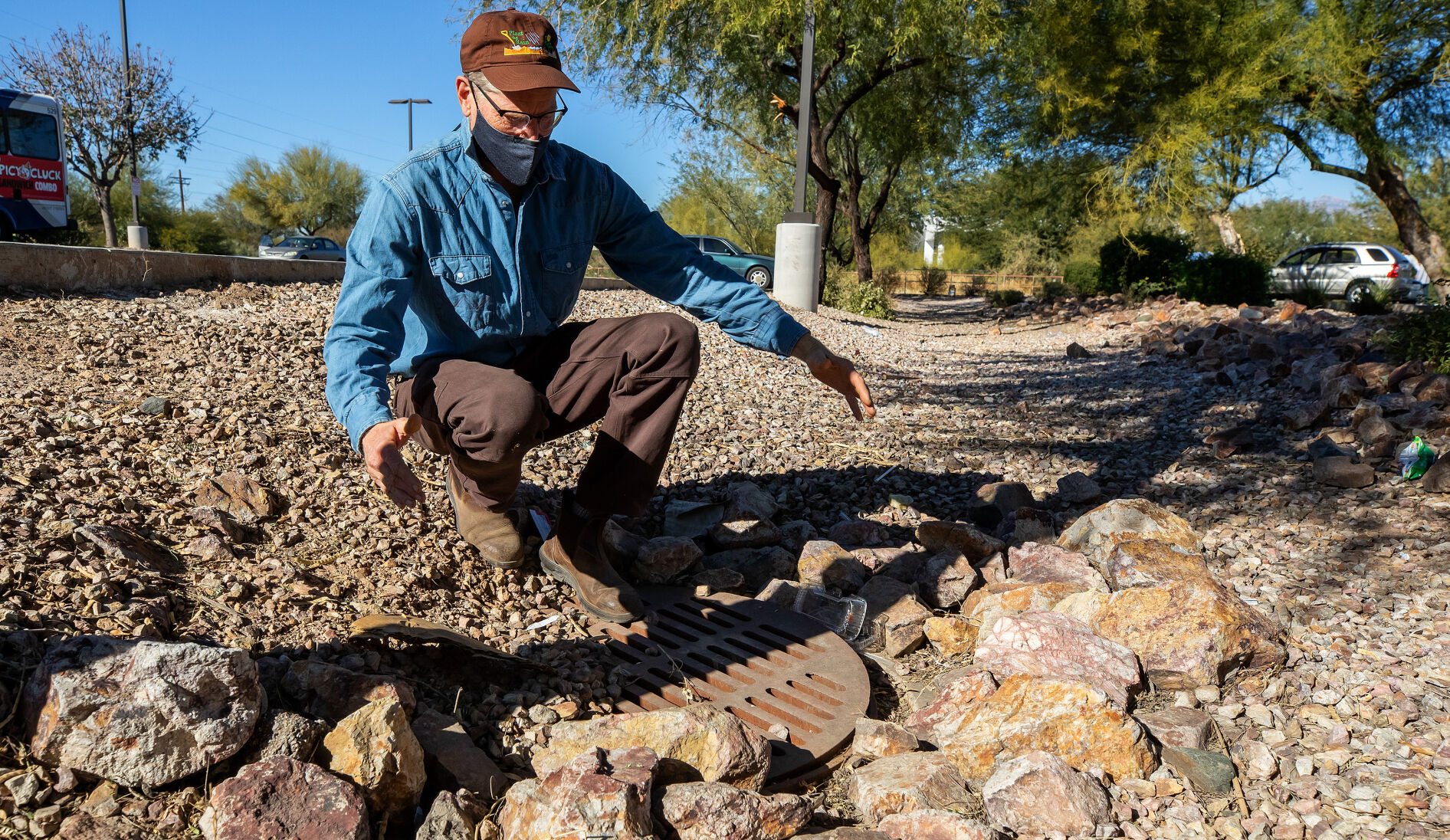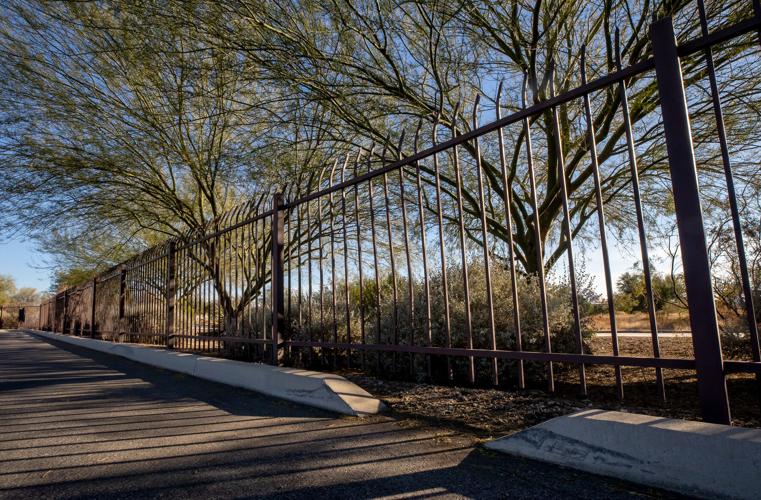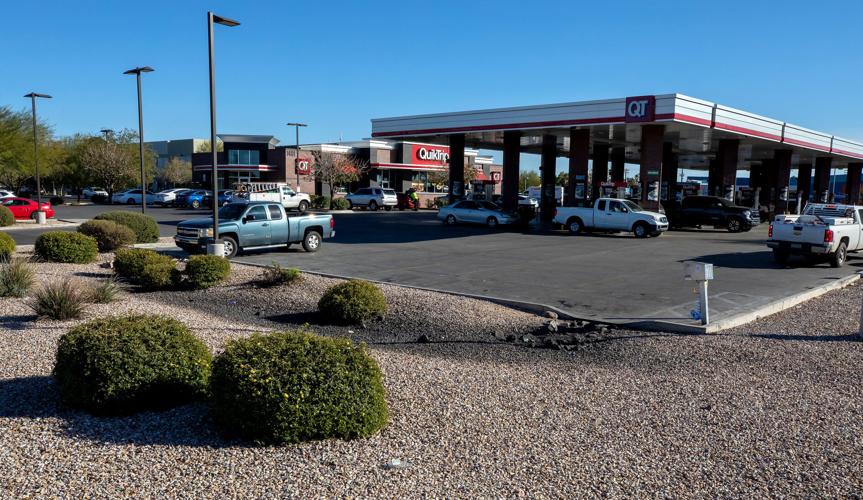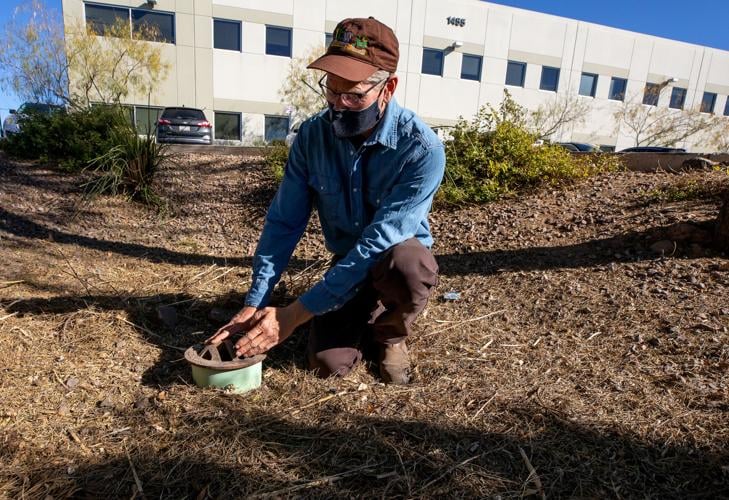Tucson won national praise in 2008 for passing a law requiring new commercial developments to get at least half of their water for landscaping from rain, rather than from drinking water. It was believed to be the first of its kind in the U.S.
But the city has not adequately enforced the law — no citations have been issued to violators — and many developments are not complying.
A city-commissioned report studied a representative sample of 12 developments in 2018. Nine used Tucson drinking water for more than half — and in most cases well over half — of the water put on landscaping.
The report, by two private experts, was not publicly released by city officials for nearly three years.
Its findings about outdoor water use were echoed in a broader investigation by city staff. They examined 41 commercial projects from 2016 to 2020 and found the vast majority were again exceeding the 50% threshold.
Nearly half were “grossly” out of compliance with the ordinance, said a memo last month to the City Council by Tim Thomure, an assistant city manager.
Thomure says the city’s enforcement has significantly improved since 2018, and that’s one reason the first report was not released until recently.
But the City Council voted unanimously Jan. 25, directing staff to produce a plan in 60 days to further improve how the ordinance is administered and enforced.
It’s imperative to do that because “we’re in a climate crisis,” said Councilman Kevin Dahl, who introduced the successful motion.
When the ordinance works as intended, rainwater harvesting can play a huge role in reducing dependence on drinking water for landscaping, Dahl said.
About 30% of the city’s drinking water supply is used outdoors, Tucson Water officials have said.
It’s frustrating for residents and experts alike to see water wasted as it runs onto pavement instead of landscaping, noted Brad Lancaster, a longtime local advocate of rainwater harvesting who co-authored the 2018 city report.
‘Design failures’
Palo verdes, mesquites and a wide variety of native and non-native, low-water use shrubs adorn the QuikTrip convenience store on Alvernon Way just south of 22nd Street. But on its west side, most of the landscaping is elevated above the level of surrounding concrete parking areas.
That means rainfall runoff can’t flow into the landscaped areas. So the vast majority of the water nourishing plant life at the site comes from Tucson’s drinking supplies, while the majority of runoff flows into streets and storm drains, the 2018 report found.
“This site failed miserably,” said Lancaster, as he walked around the QuikTrip property in late January. While the rest of the site’s design for collecting stormwater “largely got it, the west side, I’d say, missed the boat.”
Each new commercial site is required to draw up an outdoor watering budget, incorporating projected demand and supplies, to show how the project would meet the 50% rainwater harvesting requirement and to get city approval.
But Lancaster’s study found the QuikTrip on Alvernon used 547% more city water outdoors in 2017 than its budget said. That made QuikTrip the second-highest user of drinkable water compared to its budget of the 12 projects studied, the report found.
But he said the convenience store franchise was not at fault. He blamed the site’s developers for designing, and the city for approving, landscaping, grading and water harvesting plans that did not match.
“There’s no way to easily and inexpensively let gravity send water to the landscape,” Lancaster said. “As a result, the landscaping is draining stormwater to the pavement.”
A QuikTrip spokeswoman told the Star that plans for the store were reviewed and approved by the city before construction, and the basins were properly constructed — per approved plans — when the store opened in 2012.
“We have no information on current rainwater usage and will need to look into the numbers provided in the study before we can provide further comment on that issue,” said Aisha Jefferson-Smith, QuikTrip’s corporate communications manager.

An inlet, or break, in the concrete curb allows rainwater to be harvested in the landscape basin at a city Park and Ride on East Old Vail Road in Rita Ranch. The trees are bigger and healthier in areas where rainwater is harvested, said Lancaster.
Climate change mitigation
At the time the city ordinance was passed, rainwater harvesting was seen by many as a fringe practice. But its usage among Tucson homeowners has since grown widely, fueled in part by city rebates to pay for water storage cisterns and rainfall-friendly landscape designs.
It’s now seen by many environmentalists and other supporters not only as an alternative to city water use, but as a way to help Tucson adapt to global warming by nourishing the growth of cooling shrubs and trees.
“Water harvesting is an integral part of our climate change adaptation and mitigation strategy,” said Dahl.
But as far as commercial water use is concerned, Lancaster’s report outlined these problems with enforcement of the 2008 law:
Failures by city Planning and Development Services staff to insure water harvesting plans submitted by developers matched grading plans, and that construction work matched harvesting plans.
The city has not cited any violators. The law says violators can be required to submit to the city a landscape irrigation audit.
Projects falling under the law generally failed to submit required annual reports showing water use and metering data. The only reports ever written about companies covered by the ordinance were seven that Tucson Water prepared back in 2013.
Thomure said in his memo to the council that city staff already took several steps to improve administration of the ordinance. He recommended a page-long list of other possible actions.
One reason the city did not publicly release the report when submitted is that staff improved its design review process starting in 2018 after conducting an initial evaluation of the ordinance, including Lancaster’s review, Thomure said in an email to the Star. The council was not part of that process, so the report was distributed only to staff, he said.
“Since that time, we have continuously worked to improve our processes and performance, as we do in all of our efforts as a city,” he said. “The current staff performing the plan reviews are doing an excellent job.”
The city released the report after the City Council decided last fall to review it at the request of its Citizens Water Advisory Committee, Thomure said.
Lancaster responded that “I would assume” enforcement would have improved sooner and more completely had the report been released sooner. He learned only in a December 2021 meeting with Development Services staff that a key change — returning a project’s plans to its developer when they don’t match — was instituted last year, he said.
“The changes that were made in 2021 could have been made in 2019, it seems to me. I did ask a number of times, ‘Is this (report) coming out? What’s going on?’ And I never got a hard answer,’” Lancaster said.

A black stain from previous water flows can be seen on the northwest side of QuickTrip on South Alvernon Way in Tucson. The basin is not deep enough and there is too much landscape where water isn't reaching, said Lancaster.
Site managers unaware
Lancaster and Ann Audrey, an independent hydrologist, visited the 12 projects in 2018 and pored through plans their developers submitted to the city covering water harvesting, landscaping, irrigation and grading. Ten projects were businesses, one was a city Park and Ride facility, and one was an El Rio Community Health Center.
The researchers submitted a draft report, for which they were paid $15,000, to Tucson Water in December 2018.
The sites were chosen to be representative of some 300 commercial projects permitted and built since the harvesting ordinance passed, Lancaster said.
At nine of the 12 sites, water harvesting plans did not match designs shown on grading plans. About 70% of the time, the water harvesting basins were shallower than designed for, the study found. At some sites, no basins were built.
Of the inlets created to allow rainwater to flowing from parking areas into the basins for landscaping, 44% were not fully functional.
When Lancaster interviewed site managers for these projects, none were aware of the rainfall harvesting requirement, he said.
Particularly frustrating, he said, was seeing many locations where very easy opportunities to collect significant amounts of rainwater were missed.
Like the QuikTrip site, many landscaped areas were higher than the pavement that was supposed to direct rainwater to them. Curb cuts allowing the water into landscape “islands” often were not placed properly, he said.
The way the majority of these commercial sites were built “dehydrates” the community, he said.
“It drains the rain right off the site. It increases downstream flooding. It also increases (ambient) temperatures, while rainwater harvesting reduces them. The more moist your soil, the cooler the soil and the more vegetation you can support.”
Drinking water usage
The Cadence apartment complex at 350 E. Congress St. had the biggest gap between outdoor water use and its budgeted water use — 1,047% — of the 12 sites, Lancaster’s report said.
Five sites used 184% to 481% more than budgeted.
The city staff’s follow-up analysis concluded that annual outdoor use of city water over five years for 11 of 41 properties it reviewed topped 500% of budgeted annual use. Eight went 250% to 500% over budget. Eight more ran 125% to 250% over budget.
The 41 properties’ total use in five years was roughly equivalent to what would have been used before the ordinance’s passage, when drinkable water supplied 100% of irrigation demands, Thomure wrote.
Only one-third of the properties met ordinance requirements.
“Overall for these 41 sites, usage was 289% higher than expected, with a total annual average use of 10.6 million gallons,” he wrote.
Disappointing outcome
The reasons for non-compliance are complex.
The water harvesting plan for QuikTrip on Alvernon, for example, showed 10 basins would be designed to capture stormwater. Its grading plan showed four basins, Lancaster said.
But only two such basins were actually built to function properly, and two others “were filled in with gravel and rock.”
For that reason, Lancaster disputed QuikTrip spokeswoman Jefferson-Smith’s statement that the site’s water harvesting basins were built “per the city’s approved plans.”
Gary Grizzle, a landscape architect involved in designing the store’s water harvesting system, called the store’s high water use “disappointing.” Grizzle is landscape architecture manager for WLB Group, which designed grading and other plans for the QuikTrip.
“I wonder if it’s the timer. There’s an irrigation controller that is set, and it needs to be adjusted. They usually have weather sensing information on it,” Grizzle said. “It could be a maintenance thing. Usually, obviously, a company would hire a landscape maintenance company to come clean up and check everything. I assume part of that was part of their task.”
He added: “We design it per the ordinance, and it goes through the city review. We usually go back and forth a couple of times for the review, and it gets approved. That’s how it’s supposed to be built. I don’t know how it gets built. We typically don’t monitor it while it’s under construction.”
Water leaks
The Cadence had definite signs of water leaks, Lancaster said.
“You would see a whole area of really moist soil in an area where there’s no vegetation, at least on the day of inspection. The water use was much bigger than the site was designed to use.
“We did our site inspection when there had not been any rain. So there’s no way it was rain” that wetted the soils, he added.
In addition, Cadence’s water harvesting plans called for 18 basins, but those at the site were so shallow it was hard to tell how many were built, he said. “They need to be 4 to 6 inches deep for there to be stormwater capture, but that wasn’t there.”
Rosie Pina, regional manager for AMC Development Co., the Vancouver, B.C.-based company that manages Cadence, said the company only took over the site in April 2021. So its officials have no knowledge about water use under the prior owner and operator, Coastal Ridge Real Estate, of Columbus, Ohio.
Leaks and/or water line breaks were also likely issues at the city Park and Ride site studied, at 9017 E. Old Vail Road, Lancaster said.
Water use spiked there during normally low-water-use months annually from 2016 to 2018. That caused the site to use 234% more drinking water on landscaping in 2017 than budgeted.
Best-rated site
The study’s best-rated site was a Dollar General at 945 E. 22nd St.
Native blue palo verdes and mesquites and native and non-native, low-water use shrubs surrounding its parking lot thrived throughout the study period — and still do. And city records show the site used no city water from 2014 to 2018, Lancaster said.
Dollar General’s success shows the ordinance can work if administered and enforced properly, he said. The landscaping was irrigated by city water during the store’s first three years, through 2013, Lancaster said.
“Then after that, they stopped irrigating. They ceased their maintenance contract with the landscape company, and the vast majority of vegetation survived and looked good. It surpassed the goals of the ordinance.”
List of problems
In his Jan. 25 memo, Thomure said smart irrigation controllers are required by the law but are not always installed and often are not programmed correctly.
“Maintenance was also an obvious issue,” he wrote. “Problems included basins that had been filled in with sediment and other debris, lack of mulch, missing trees and shrubs, overpruning, plugged irrigation emitters and emitters watering bare earth.”
His memo noted other issues:
Technical standards the city adopted years ago to put the ordinance into effect “led to some ambiguity” in how the city reviewed projects. At the beginning, “there was not an awareness of need to coordinate the grading and landscape plans with the rainwater harvesting plans.”
The law requires regulated businesses to buy a city irrigation meter, for about $6,500, or a private “sub-meter” costing no more than $1,000. Having its own irrigation meters is the city’s only way to track a property’s water use because businesses do not report their meter readings to the city. But a city meter is not cost effective for many small properties with less water demand.
Identifying property owners and managers responsible for bills and water management is also a challenge, since corporate headquarters, not local property managers, typically pay national chain stores’ bills.
Working on fixes
Improvements Thomure said the city has made include:
Planning and Development Services Department staff now have better practices for reviewing plans and inspecting sites to match a developer’s grading, landscaping and water harvesting plans.
When landscaping, grading and hydrology plans don’t match rainwater harvesting plans, they are returned to developers for corrections.
Tracking of developments for compliance will improve once Tucson completes a system upgrade later this year to handle permits issued by five city departments.
In January 2021, the city adopted new stormwater detention design standards for flood control purposes, requiring commercial projects to capture the first half-inch of rain falling on a site. Now, city officials are conducting an analysis to see how much water is captured this way compared to what’s required under the rainwater law.
“It’s really important to remind everybody, we are never going to be taken seriously as a community unless our water future is secure,” Councilman Paul Cunningham said at the meeting where the vote was taken to fix enforcement.







